
The kola nut is the seed of certain species of plant of the genus Cola, placed formerly in the cocoa family Sterculiaceae and now usually subsumed in the mallow family Malvaceae. These cola species are trees native to the tropical rainforests of Africa. Their caffeine-containing seeds are used as flavoring ingredients in various carbonated soft drinks, from which the name cola originates.

A melon is any of various plants of the family Cucurbitaceae with sweet, edible, and fleshy fruit. It can also specifically refer to Cucumis melo, commonly known as the "true melon" or simply "melon". The term "melon" can apply to both the plant and its fruit. Botanically, a melon is a kind of berry, specifically a "pepo". The word melon derives from Latin melopepo, which is the latinization of the Greek μηλοπέπων (mēlopepōn), meaning "melon", itself a compound of μῆλον (mēlon), "apple", treefruit " and πέπων (pepōn), amongst others "a kind of gourd or melon". Many different cultivars have been produced, particularly of the true melon, such as the cantaloupe and honeydew.
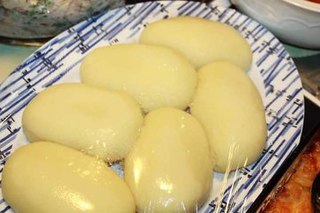
Fufu is a pounded meal found in West African cuisine. It is a Twi word that originates from the Akans in Ghana. The word has been expanded to include several variations of the pounded meal found in other African countries including Sierra Leone, Liberia, Cote D'Ivoire, Burkina Faso, Benin, Togo, Nigeria, Cameroon, the Democratic Republic of Congo, the Central African Republic, the Republic of Congo, Angola and Gabon. It also includes variations in the Greater Antilles and Central America, where African culinary influence is high.

Ẹ̀bà also known as Ebe or Pinon' is a staple swallow from Nigeria, Togo and Benin, also eaten in the West African sub-region and other African countries. The term èbà originates from Ewe people which means "mud", metaphorically compared to the texture and colour of the staple. It is a cooked starchy vegetable food made from dried grated cassava (manioc) flour commonly known as garri all across West Africa. It is often eaten with rich soups, hot grinded pepper and stews, with beef, stockfish or mutton. The dish is often described as having a slightly sour, sharp taste.

Ugali, also known as posho, nsima, papa, pap, sadza, isitshwala, akume, amawe, ewokple, akple, and other names, is a type of corn meal made from maize or corn flour in several African countries: Kenya, Uganda, Tanzania, Zimbabwe, Zambia, Lesotho, Eswatini, Angola, Mozambique, Namibia, Democratic Republic of the Congo, Malawi, Botswana and South Africa, and in West Africa by the Ewes of Togo, Ghana, Benin, Nigeria and Cote D'Ivoire. It is cooked in boiling water or milk until it reaches a stiff or firm dough-like consistency. In 2017, the dish was added to the UNESCO Representative List of the Intangible Cultural Heritage of Humanity, one of a few foods in the list.

Telfairia occidentalis is a tropical vine grown in West Africa as a leaf vegetable and for its edible seeds. Common names for the plant include fluted gourd, fluted pumpkin, ugu, "Eweroko" ,okwukwo-wiri, and ikong-ubong, "Akwukwor ri". T. occidentalis is a member of the family Cucurbitaceae and is indigenous to southern Nigeria. The fluted gourd grows in many nations of West Africa, but is mainly cultivated in southeastern Nigeria and it is used primarily in soups and herbal medicines. Although the fruit is inedible, the seeds produced by the gourd are high in protein and fat, and can, therefore, contribute to a well-balanced diet. The plant is a drought-tolerant, dioecious perennial that is usually grown trellised.

Àmàlà is a staple swallow food originating from Nigeria popularized by the Yoruba ethnic group of southwestern Nigeria and other parts of Yorubaland. It is made of yam, cassava flour, or unripe plantain flour. Tubers of yams are peeled, sliced, cleaned, dried and then ground into flour. It is also called èlùbọ́. Yams are white in colour but turn brown when dried which gives àmàlà its colour. It is a popular side dish served with ewédú and gbẹ̀gìrì, but is also served with a variety of other ọbè (soups), such as ẹ̀fọ́, ilá, and ogbono.
Irú (Yoruba) or Dawadawa (Hausa) or Eware (Edo) or Sumbala (Bambara) or Narghi (Fula) is a type of fermented and processed locust beans used as a condiment in cooking. It is similar to ogiri and douchi. It is popular throughout West African cuisine. It is used in cooking traditional soups like egusi soup, okro soup (ILA), Ewedu soup, and ogbono soup.
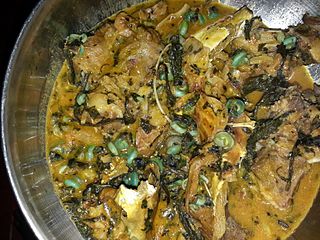
Ogbono Soup is a Nigerian dish made with ground dry ogbono seeds. Ogbono seeds are originated and were first grown in Southern Nigeria with considerable local variation. According to research by Chris Chinaka and J.C. Obiefuna, Ogbono is an indigenous forest tree associated with plants classified as 'non-timber forest products. It goes by various indigenous names among Nigerians. The Common use of the word “ogbono” in general Nigerian parlance stems from the Igbo name for the word. Among the Nupe, it is called 'pekpeara', 'ogwi' in Bini, 'uyo' in Efik, and 'oro' or ‘apon’ in Yoruba. Although ogbono and ugiri, the Igbo name for bush-mango, are very similar indeed and often regarded as equivalents, there is technically a distinction.
Sierra Leonean cuisine consists of the cooking traditions and practices from Sierra Leone. It follows the traditions of other West African cuisines. The country has 16 tribal ethnic groups.

West African cuisine encompasses a diverse range of foods that are split between its 16 countries. In West Africa, many families grow and raise their own food, and within each there is a division of labor. Indigenous foods consist of a number of plant species and animals, and are important to those whose lifestyle depends on farming and hunting.

Nigerian cuisine consists of dishes or food items from the hundreds of Native African ethnic groups that comprises Nigeria. Like other West African cuisines, it uses spices and herbs with palm oil or groundnut oil to create deeply flavored sauces and soups.
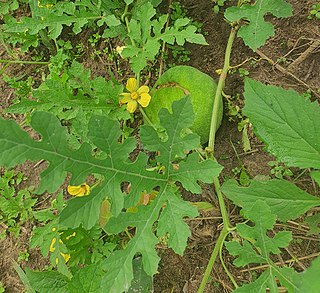
Melothria sphaerocarpa is a species of melon native from southern Mexico and the Dominican Republic through Central America to tropical South America. It has been introduced to western tropical Africa, where has been known under the synonym Cucumeropsis mannii, and is grown for food and as a source of oil, more often for the seed oil than for the fruit.

Egusi sauce or egusi soup, prepared with egusi seeds as a primary ingredient. Egusi seeds are the fat- and protein-rich seeds of certain cucurbitaceous plants. Egusi sauce is common and prevalent across Central Africa as mbíka, and may be served atop rice, cooked vegetables, or grilled meat, such as goat, chicken, beef, or fish. It may also be served atop fufu, omelettes, amala, and eba, among other foods. Egusi soup is also consumed in West Africa, sometimes with chicken.
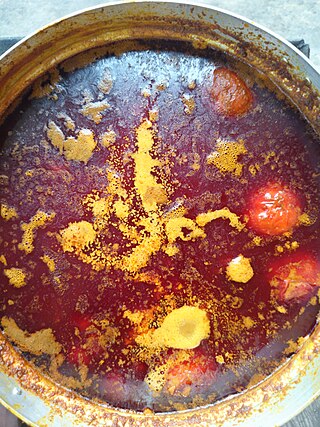
Palm nut soup or banga is a soup made from palm fruit common in the Cameroonian, Ghanaian, Nigerian, Democratic Republic of Congo and Ivorian communities. The soup is made from a palm cream or palm nut base with stewed marinated meats, smoked dried fish, and aromatics. It is often eaten with starch, fufu, omotuo, banku, fonio, or rice. The use of the palm fruit in cooking is significant in Ivorian, Cameronian, Nigerian, Ghanaian, Liberian and other West and Central African cuisine.

Okra or Okro soup is primarily associated with the Igbo tribe of Nigeria and is prepared using the edible green seed pods of the okra flowering plant as a primary ingredient. Other vegetables can be added to the soup as well, such as ewedu, kerenkere, or Ugu leaf. Depending on the specific variant being prepared, okra soup can have a clear broth or be deep green in colour, much like the okra plant itself. Okra can have a slippery or "slimy" mouthfeel. The edible green seed pods can also be used in other stews and soups, such as the American dish gumbo.

Efo riro is a vegetable soup and a native soup of the Yoruba people of South West Nigeria and other parts of Yorubaland. The two vegetables most commonly used to prepare the soup are Celosia argentea and Amaranthus hybridus. The history of Efo riro is deeply rooted in the Yoruba culture. It was traditionally prepared with the locally grown vegetables, meat, fish, and a mixture of spices. The choice of vegetables and proteins varies based on personal preference and regional availability. The most commonly used vegetables are spinach, pumpkin leaves, or sorrel leaves, often combined with bell peppers, chili peppers, and onions.
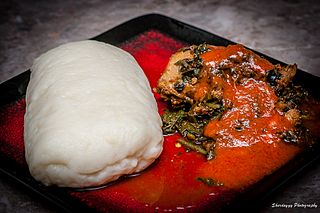
Pounded yam is a Nigerian swallow or Okele food. It is commonly prepared by pounding boiled yam with mortar and pestle Pounded yam is similar to mashed potatoes but heavier in consistency. It is a smooth delicacy eaten with the hands.
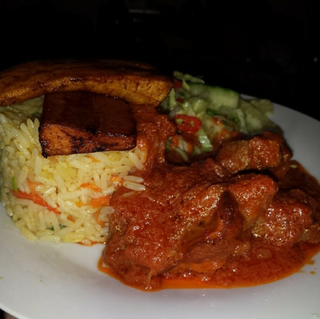
Obe ata (Yoruba) is a stew or sauce used in Yoruba cuisine and meals found in Nigeria, Benin and Togo. In concept, it is similar to that of French mother sauces: a sauce from which other sauces are made, or to the Mexican Mole. It can be used as the base with which Jollof rice is made, either at the initial or near prepared state. Rice, yam and bread are also eaten with it. In Nigerian cooking the sauce is "ubiquitous".





















